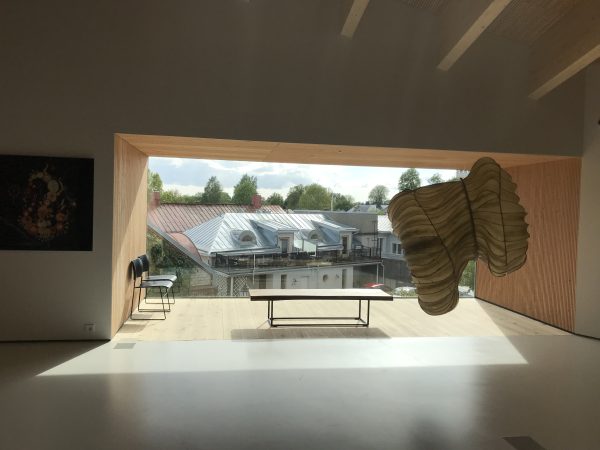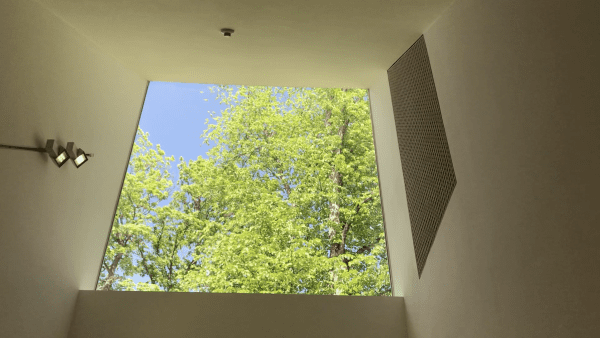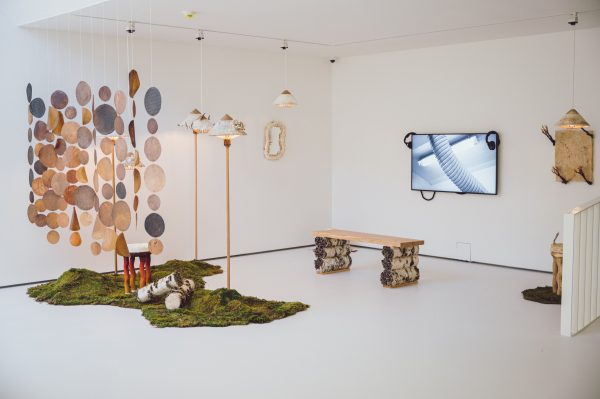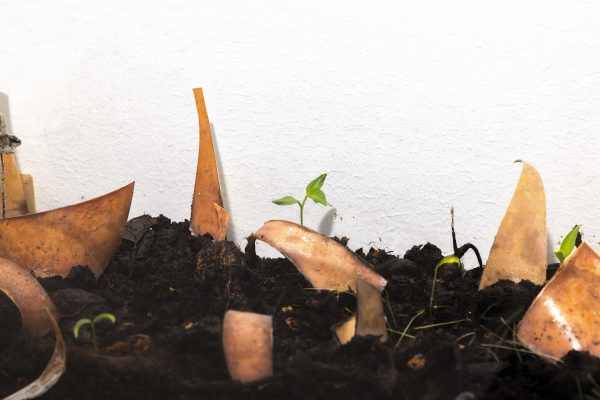Review: Climate & Art – Alternative Approaches in Chappe Museum, Tammisaari
As is often the case in museums, the first thing I do upon arriving at Chappe is use the toilet. However, this time I am caught mid-squat by a button for an audio artwork (by Harrie Liveart). A quick bodily task turns into an 8-minute meditation on the circular journey of an apple (which I had happened to just eat) traveling from the tree through my digestive tract and eventually back into a tree. I trace my fingertips over the engraved image of an apple tree on the cool porcelain of the toilet tank. Before exiting, I pause to let the faucet water flow over my hands; the earth’s circular christening.

Museums for me have the tendency to feel like sterile, isolating arenas for artworks to be extracted from their life processes into boundaried, static objects put on display for the gaze of the viewer. I recognize my own tendency for a quick scan with my eyes and then snapping a picture on my iphone. Yet I continue to have a nagging urge to discover other ways of encountering and ingesting artwork. The exhibition Climate & Art – Alternative Approaches was curated in memory of Albert de la Chapelle (1933–2020) the donor and founder of the museum whose primary interest was environmental values and sustainable development. This combination of interests, site, mission and artwork, proposed a unique opportunity. I decided to approach the Chappe building in the awareness of how it is inextricably tethered to the place where it stands and to the art it houses. What if I encountered the museum as a living ecosystem where you cannot so easily separate one element from another? And how might this symbiotic perspective create a gaze that allows me to see the artworks as living processes connected to my own body?
When first ascending the stairs to the main exhibition space, I am arrested by the light cast across a bright, pine-wood beamed ceiling, and a skylight tucked in a lofted corner. The block of text on the wall catches me and I am reluctant to untangle its words into my brain, but the experience is slightly relieved by the black letters resting on textured, seaweed-green organic paper– a language of visual sensation I can more easily access. Stepping further into the space I am thrust to the left by the long-cast of glass of an aquarium sized window revealing the town outside. The window’s framing of the moving world and the bench (hand-made from a tree felled from the site during the building process) positioned in front, creates a certain theater. Sitting there, small details of rolling clouds and passersby on the street below come to me with an uncanny drama. Meanwhile, directly across the space, is a giant photograph of the forest, unmoving. In the basement space, I become mesmerized by the view of shivering leaf-laden branches held in focus by a skylight. I lay on my back on the floor and prop my head to watch as the wind conducts a remarkable patterning of gestures; a symphony of green.

The primary theme of the exhibition is stated to be “fostering a more symbiotic relationship that is generated through the connection between people and extends to other species and the planet.” I muse whether symbiosis is only metal posturing of an ideal unless it is lived in every space between. Connection that fosters relationship isn’t a fusing, but requires space held between. Symbiosis is an interaction of reciprocity between two different organisms and, in simple terms, it is their unique properties that allow them to be mutually beneficial. Perhaps the paradox is that the interconnection we seek to foster between humans and nonhumans requires that we are guardians of each other’s singularity, while also taking a posture of submission to meet the other.
What could symbiosis enact in an art viewing context? When we expect to engage a predominately visual display, we rely almost exclusively upon our sense of sight. I wonder if we have to fully acknowledge the culturally developed hierarchy of our human faculties. How sight has become dominant and how the eyes can atrophy by the influence of the photographic appendage. What if our symbiotic responsibility in a museum ecosystem is to cultivate our gaze to be more generous and to submit to the subject of our gaze as a living being that perceives us in return? (This “reciprocity of perception” is a concept from David Abram that I have been investigating ever since reading The Spell of the Sensuous).
What I mean is to be able to look at an artwork and realize it has an entire life of processes that simultaneously evolved and matured it to this moment of encounter and continue to transform it.
With this thought, each artwork becomes a window much like the actual windows that so elegantly characterize the Chappe building – they are glimpses into other time scales, other places, and processes with a momentum that carries the viewer from past to present and into an imagination of what continues. For example, in the artworks by the Caracara Collective we are invited to witness both the initiating processes in the video documentation and the living outcome of symbiosis between fungi and trees combined with traditional woodworking techniques. Yet it takes slowing down (and reading the text!) to realize this work is not a frozen artifact, but that elements are still actively causing the mushrooms to grow.
Knowing that this artwork is a continuum is vital not just for understanding the symbiosis and collaborative creation process inherent in the work, but to cultivate in me a gaze that is more sustainable. What I mean is to be able to look at an artwork and realize it has an entire life of processes that simultaneously evolved and matured it to this moment of encounter and continue to transform it. This type of living artwork met with attention – a presence of mind and a focusing of the eyes for a sustained duration – begins to cultivate a relational encounter, an exchange of perception. I wonder if this relational visual encounter might inscribe in me an image of that artwork that lives on in my memory, and that by being stored in the living medium of my body, it might ferment over-time and begin to work on me, feeding my imaginal insides.

To gather in an artwork in a sustainable way, it feels essential to practice curiosity; an inquiring gaze. Perhaps it also requires recognizing that an artwork is dimensional and moving even if only on a microscopic level. Dear visitors, do not rely on the curator’s placement, or you default eye-level. I urge you to get down on your knees with Carriers by Noora Sandgren: twist your head sideways between the layers of wood pallets, stick your nose up close to avocado, apple, and pepper seeds, start confusing back and front and sides, and up with down. Touch your eyes against the black of forged Alder cones foraged, raw flax, discarded cotton sheet, plastic netting, snow water. Take a dip into the rich material list of the home-made papers: “bush seeds, flower fibre, tissue paper, egg carton, nettle leaves/tea, newspaper. And blueprints: felted wool of landscape carers – Åland, home garden raspberry sprouts reformed by hare bodies, work week’s coffee filter paper.” Then maybe brush your fingertips across the leathery skin of the Kombucha SCOBYs of Symbiosis by Hannah Fletcher and let your nose be confounded by its smell. Find a continuum of aliveness in Images – seeds, planting and harvesting, 27.3.–3.9.2023, by Noora Sandgren where the growth of the compostmatter is a live event. Wonder about her choice of title and whether we might begin to understand images as narrative continuums of time and matter in which we participate. How might this shift what we understand an image to be and help cultivate a more sustainable gaze? And how might we not become overwhelmed by visual data and reach to capture with our phone camera (to look at more closely later?), but linger with a gaze of genuine attention? Let your eyes drool along the rows of jars of Katja Syrjä’s natural material archive and feel the memory of hands collecting, treasuring. Try running past Julia Lohmann’s delicately rattan-ribbed algae sculpture, Corpus Maris II, and watch the air animate its cavernous body. Or, after touching the supple skin of the seaweed sample on the wall, lie underneath the sculpture and sense the hovering lightness of its sustainable materials, their memory of relationship between human and nonhuman coastal communities.
Can we bear-witness to a shared life between ourselves and these artworks as multispecies organisms? How might we use this exhibition to recognize and step into a circular economy?

On a bigger scale, I ponder how this museum building facilitates a circular economy of the gaze by how it directs the eyes outside and inside interchangeably; how windows and skylights and wood from trees that grew on the very ground it was built, support a symbiosis in how a visitor walks through the exhibition and how they encounter the bodies of artworks with the materiality of their own body. I think about how this art as exchange might deepen the pathways of distributing resources and knowledge in an art museum. I circle back to thinking how inscribing the life of an artwork through the sustained interaction of our bodily faculties (remember how I began in the toilet) and our sustained gaze, might create embodied memories. How might these memories, these animate images of artworks, be a seed, carried in the living medium of our bodies? If we actually digested what we saw, might this image seed continue to live in our imagination, composting into our consciousness, and travel through our digestive tract to someday become a tree that bears fruit?
Text: Alyssa Coffin
Alyssa Coffin is an interdisciplinary artist from New England, USA, currently based in Finland. She is finishing her master’s in Time and Space Arts at The University of The Arts, Helsinki. Her practice includes walking, attention, curiosity, sensory engagement, and writing/spoken word.
Climate & Art – Alternative Approaches 16.4.–3.9.2023
Chappe, Tammisaari
Participating artists: Saara Alhopuro, Caracara Collective, Tanja Marjaana Heikkilä, Julia Lohmann, Mia Makela, N55 / ion Sørvin & Till Wolfer, Erik Sjödin, Studio Hendrikx (Bob Hendrikx), Superflex, Katja Syrjä, The Sustainable Darkroom (Hannah Fletcher, Noora Sandgren & Alice Cazenave), Jyrki Tsutsunen & Tatu Rönkkö
The publication of this review has been supported by the Finnish Art Society’s Signe Tandefelt grant.